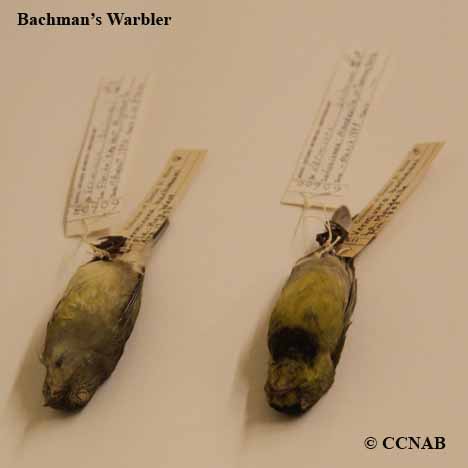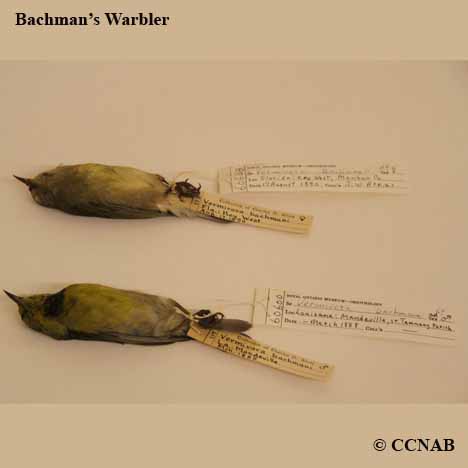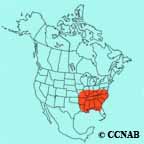North American Bird Search Box
This search box can be used to find bird species using bird's english, french or latin name, or to identify bird by its 4 letter Alpha Code
Field Guide for all the Birds of North America
Bachman's Warbler
4 Letter (english names) Alpha Code: BAWA (6)
Paruline de Bachman
Vermivora bachmanii
Information, images and range maps on over 1,000 birds of North America, including sub-species, vagrants, introduced birds and possibilities

Species: The Bachman's Warbler (Vermivora bachmanii) is probably extinct, with no sightings in North America since 1962 and the last confirmed sighting was in Cuba in the mid-1980s. It was first discovered by the reverend John Bachman in the early 1830s. This bird species was reported as a rather common warbler in the 1800s but became rare and endangered by the 1900s. The Bachman's Warbler was found in the swampy areas of the southeastern states, where it is thought to have made its nest in canebrakes, a form of bamboo thicket. It is speculated that its demise was due to the loss of habitat, through logging and the forming of settlements
Distinctions: The male has a black bib, yellow breast, chin and face, dark cap with a bluish gray crown and an olive-green back. The female is somewhat similar without the dark bib or black cap. Both sexes have thin curved bills and show a large area of white in their undertails.
Voice: Nasal or buzzy tone notes, similar to the Blue and Golden-winged Warblers.
Nesting: Three to five white eggs. Suspended from a fork in branches of undergrowth or canebrakes. The nest is composed of fine grasses, leaves and Spanish moss.
- Summer
- Year Around
- Winter

Images of a female and male Bachman's Warbler, courtesy of the Royal Ontario Museum, ROM, located in Toronto, Ontario, Canada.
Life, Habitat & Pictures of the Bachman's Warbler
| B L | W W | W | Family | Latin Name |
|---|---|---|---|---|
| 4.5" 10.7cm | 7.5" 18.3cm | 0.35oz 9.9g | Parulidae | Vermivora bachmanii |

Distribution: The Bachman's Warbler was found in swamps and bottomlands of the southeastern states. It was never known to be an abundant bird. Unfortunately, these birds were shot and killed by collectors, as they migrated through their known Florida corridors. It was seen in North Carolina, west to Missouri, south to Louisiana and east to Georgia. It migrated through Key West in the state of Florida to Cuba and to the Isles of Pines during its migration periods.
Reference to Other Bird Site:
ABA - American Birding Association This site represents an organization that maintains official records of all birds species that have been proven to have been seen inside the perimeters of the North American Continent and the surrounding bodies of water. Regular revised versions are posted to keep the bird list current at all times. This is the list used by all serious birders over their lifetime. You may be aware of the movie called the "Big Year". It was with this list that all the competing birders used in an attempt to set a new record as to how many bird species that could be seen by an individual birder in one calendar year.